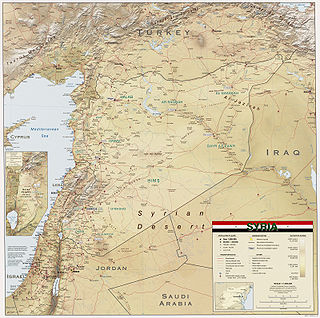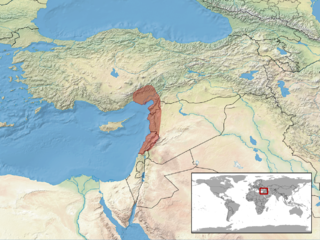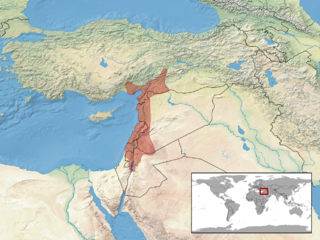
Syria is located in Western Asia, north of the Arabian Peninsula, at the eastern end of the Mediterranean Sea. It is bordered by Turkey to the north, Lebanon and Israel to the west and southwest, Iraq to the east, and Jordan to the south. It consists of mountain ranges in the west and a steep area inland. In the east is the Syrian Desert and in the south is the Jabal al-Druze Range. The former is bisected by the Euphrates valley. A dam built in 1973 on the Euphrates created a reservoir named Lake Assad, the largest lake in Syria. The highest point in Syria is Mount Hermon on the Lebanese border. Between the humid Mediterranean coast and the arid desert regions lies a semiarid steep zone extending across three-quarters of the country, which receives hot, dry winds blowing across the desert. Syria is extensively depleted, with 28 percent of the land arable, 4 percent dedicated to permanent crops, 46 percent utilized as meadows and pastures, and only 3 percent forest and woodland.

The Tigris and Euphrates, with their tributaries, form a major river system in Western Asia. From sources originating in Eastern Anatolia, they flow by/through Syria through Iraq into the Persian Gulf. The system is part of the Palearctic Tigris–Euphrates ecoregion, which includes Iraq and parts of Turkey, Syria, Iran, Saudi Arabia, Kuwait, and Jordan.

Günther's vole is a species of rodent in the family Cricetidae, also known by the name Levant vole. It is found in Bulgaria, Greece, Iran, Iraq, Israel, Jordan, Lebanon, North Macedonia, Serbia and Montenegro, Syria, Turkey, and Libya. In Libya, its natural habitats are temperate grassland, subtropical or tropical high-altitude grassland, and arable land. In Israel, it is common in lowland agricultural fields, in peak years becoming a major crop pest.

The near Eastern fire salamander, in Arabic arouss al-ayn, is a species of salamander in the family Salamandridae found in Iran, Iraq, Turkey, Syria, Lebanon, and Israel. Its natural habitats are subtropical dry shrubland and forests, often near rivers and freshwater springs. It is threatened by habitat loss.

The southern banded newt is a species of salamander in the family Salamandridae found in Iraq, Israel, Jordan, Lebanon, Syria, and Turkey.
Barbatula eregliensis is a species of ray-finned fish in the family Balitoridae. It is found only in Turkey. Its natural habitats are swamps and freshwater lakes. It is threatened by habitat loss.
Barbatula samantica is a species of ray-finned fish in the family Balitoridae. It is found only in Turkey. Its natural habitat is rivers. It is threatened by habitat loss.
Oxynoemacheilus seyhanensis, the Samanti loach, is a species of ray-finned fish in the family Nemacheilidae. It is found only in Turkey. Its natural habitat is rivers. It is threatened by habitat loss.
Cobitis levantina is a species of ray-finned fish in the family Cobitidae. It is found in Lebanon, Syria, and Turkey. Its natural habitats are rivers, intermittent rivers, and irrigated land. It is threatened by habitat loss.

Phoenicolacerta laevis, the Lebanon lizard, is a species of lizard in the family Lacertidae. It is found in Cyprus, Israel, Jordan, Lebanon, Syria, and Turkey. Its natural habitats are temperate forest, Mediterranean-type shrubby vegetation, rocky areas, arable land, pastureland, plantations, and rural gardens. It is threatened by habitat loss.

Eirenis levantinus is a species of snake in the family Colubridae . It is found in Lebanon, Syria, and Turkey. Its natural habitats are Mediterranean-type shrubby vegetation, plantations, and rural gardens. It is threatened by habitat loss.

Eirenis lineomaculatus is a species of snake in the family Colubridae. It is found in Israel, Jordan, Lebanon, Palestinian Territory, Occupied, Syria, and Turkey. Its natural habitats are Mediterranean-type shrubby vegetation, rocky areas, and rural gardens. It is threatened by habitat loss.
Ceriagrion georgifreyi is a species of damselfly in the family Coenagrionidae. It is found in Greece, Syria, Turkey, and possibly Lebanon. Its natural habitats are rivers and freshwater springs. It is threatened by habitat loss.
Coenagrion syriacum is a species of damselfly in the family Coenagrionidae. It is found in Israel, Lebanon, Syria, and Turkey. Its natural habitats are swamps, freshwater marshes, ponds, and canals and ditches. It is threatened by habitat loss.
Gomphus davidi is a species of dragonfly in the family Gomphidae. It is found in Israel, Jordan, Lebanon, Syria, and Turkey. Its natural habitats are swamps, freshwater marshes, ponds, and canals and ditches. It is threatened by habitat loss.
Onychogomphus macrodon is a species of dragonfly in the family Gomphidae. It is found in Israel, Jordan, Lebanon, Syria, and Turkey. Its natural habitat is rivers. It is threatened by habitat loss.
Oxynoemacheilus namiri, the Levantine loach, is a species of ray-finned fish in the genus Oxynoemacheilus. This species is common and widespread in the drainage system of the Orontes in Turkey and Syria, as well as in coastal streams in Syria south of the border with Lebanon, where it can be found in springs, reservoirs, streams and rivers.
Oxynoemacheilus argyrogramma, the two-spot loach is a species of ray-finned fish in the genus Oxynoemacheilus. This species is found in the drainage of the Queiq River in Syria and Turkey, and the upper Euphrates drainage in Turkey and possibly in this drainage in Syria and Iraq. It has almost been extirpated from the Queiq as this river has virtually dried out but it remains abundant in the Euphrates. This species can be found in a wide range of habitats as long as there is a moderately fast current from small upland streams to banks of large rivers. It can also occur in stagnant water bodies such as reservoirs. It is threatened by water abstraction, lowering rainfall due to climate change and the construction of dams. The economic development of the area where this species occurs exacerbates these threats. Freyhof and Özuluǧ published a paper in 2017 that argued that Oxynoemacheilus euphraticus was a valid species and not a synonym of O. argyrogramma.
Salix libani, the Lebanese willow, is a species of willow native to the east of the Mediterranean Basin. It is found in Turkey, Syria and Lebanon and is threatened by water pollution.
The wildlife of Lebanon refers to the flora and fauna of Lebanon, a country located at the eastern end of the Mediterranean Sea. The country has four main geographical areas: the coastal plain, Mount Lebanon, the Beqaa Valley and the Anti-Lebanon Mountains. The climate is Mediterranean, with the coastal regions experiencing hot, humid summers and cool, wet winters, and the elevated areas inland experiencing colder winters with snow that lingers on into the summer. The country offers a variety of habitats for wildlife, including mountains, valleys, marshes, coastal plains, salt marshes and sea coasts.








